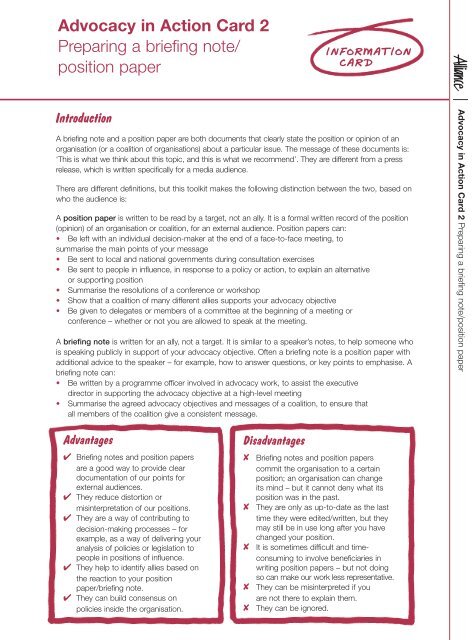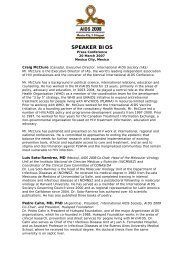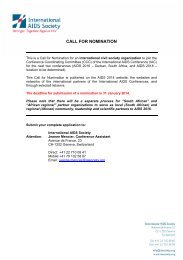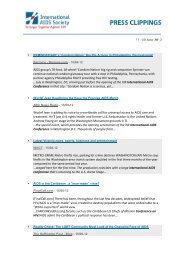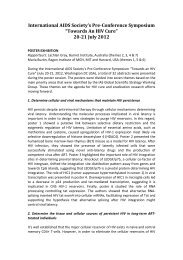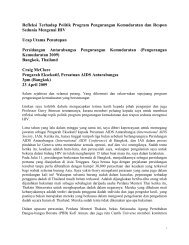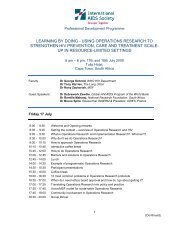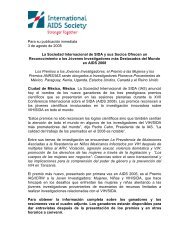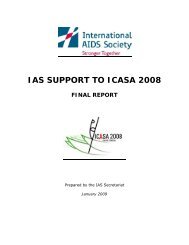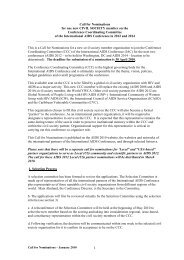Advocacy in Action - International AIDS Society
Advocacy in Action - International AIDS Society
Advocacy in Action - International AIDS Society
Create successful ePaper yourself
Turn your PDF publications into a flip-book with our unique Google optimized e-Paper software.
<strong>Advocacy</strong> <strong>in</strong> <strong>Action</strong> Card 2<br />
Prepar<strong>in</strong>g a brief<strong>in</strong>g note/<br />
position paper<br />
INFORMATION<br />
CARD<br />
Introduction<br />
A brief<strong>in</strong>g note and a position paper are both documents that clearly state the position or op<strong>in</strong>ion of an<br />
organisation (or a coalition of organisations) about a particular issue. The message of these documents is:<br />
‘This is what we th<strong>in</strong>k about this topic, and this is what we recommend’. They are different from a press<br />
release, which is written specifically for a media audience.<br />
There are different def<strong>in</strong>itions, but this toolkit makes the follow<strong>in</strong>g dist<strong>in</strong>ction between the two, based on<br />
who the audience is:<br />
A position paper is written to be read by a target, not an ally. It is a formal written record of the position<br />
(op<strong>in</strong>ion) of an organisation or coalition, for an external audience. Position papers can:<br />
• Be left with an <strong>in</strong>dividual decision-maker at the end of a face-to-face meet<strong>in</strong>g, to<br />
summarise the ma<strong>in</strong> po<strong>in</strong>ts of your message<br />
• Be sent to local and national governments dur<strong>in</strong>g consultation exercises<br />
• Be sent to people <strong>in</strong> <strong>in</strong>fluence, <strong>in</strong> response to a policy or action, to expla<strong>in</strong> an alternative<br />
or support<strong>in</strong>g position<br />
• Summarise the resolutions of a conference or workshop<br />
• Show that a coalition of many different allies supports your advocacy objective<br />
• Be given to delegates or members of a committee at the beg<strong>in</strong>n<strong>in</strong>g of a meet<strong>in</strong>g or<br />
conference – whether or not you are allowed to speak at the meet<strong>in</strong>g.<br />
A brief<strong>in</strong>g note is written for an ally, not a target. It is similar to a speaker’s notes, to help someone who<br />
is speak<strong>in</strong>g publicly <strong>in</strong> support of your advocacy objective. Often a brief<strong>in</strong>g note is a position paper with<br />
additional advice to the speaker – for example, how to answer questions, or key po<strong>in</strong>ts to emphasise. A<br />
brief<strong>in</strong>g note can:<br />
• Be written by a programme officer <strong>in</strong>volved <strong>in</strong> advocacy work, to assist the executive<br />
director <strong>in</strong> support<strong>in</strong>g the advocacy objective at a high-level meet<strong>in</strong>g<br />
• Summarise the agreed advocacy objectives and messages of a coalition, to ensure that<br />
all members of the coalition give a consistent message.<br />
<strong>Advocacy</strong> <strong>in</strong> <strong>Action</strong> Card 2 Prepar<strong>in</strong>g a brief<strong>in</strong>g note/position paper<br />
Advantages<br />
✔ Brief<strong>in</strong>g notes and position papers<br />
are a good way to provide clear<br />
documentation of our po<strong>in</strong>ts for<br />
external audiences.<br />
✔ They reduce distortion or<br />
mis<strong>in</strong>terpretation of our positions.<br />
✔ They are a way of contribut<strong>in</strong>g to<br />
decision-mak<strong>in</strong>g processes – for<br />
example, as a way of deliver<strong>in</strong>g your<br />
analysis of policies or legislation to<br />
people <strong>in</strong> positions of <strong>in</strong>fluence.<br />
✔ They help to identify allies based on<br />
the reaction to your position<br />
paper/brief<strong>in</strong>g note.<br />
✔ They can build consensus on<br />
policies <strong>in</strong>side the organisation.<br />
Disadvantages<br />
✘ Brief<strong>in</strong>g notes and position papers<br />
commit the organisation to a certa<strong>in</strong><br />
position; an organisation can change<br />
its m<strong>in</strong>d – but it cannot deny what its<br />
position was <strong>in</strong> the past.<br />
✘ They are only as up-to-date as the last<br />
time they were edited/written, but they<br />
may still be <strong>in</strong> use long after you have<br />
changed your position.<br />
✘ It is sometimes difficult and timeconsum<strong>in</strong>g<br />
to <strong>in</strong>volve beneficiaries <strong>in</strong><br />
writ<strong>in</strong>g position papers – but not do<strong>in</strong>g<br />
so can make our work less representative.<br />
✘ They can be mis<strong>in</strong>terpreted if you<br />
are not there to expla<strong>in</strong> them.<br />
✘ They can be ignored.


